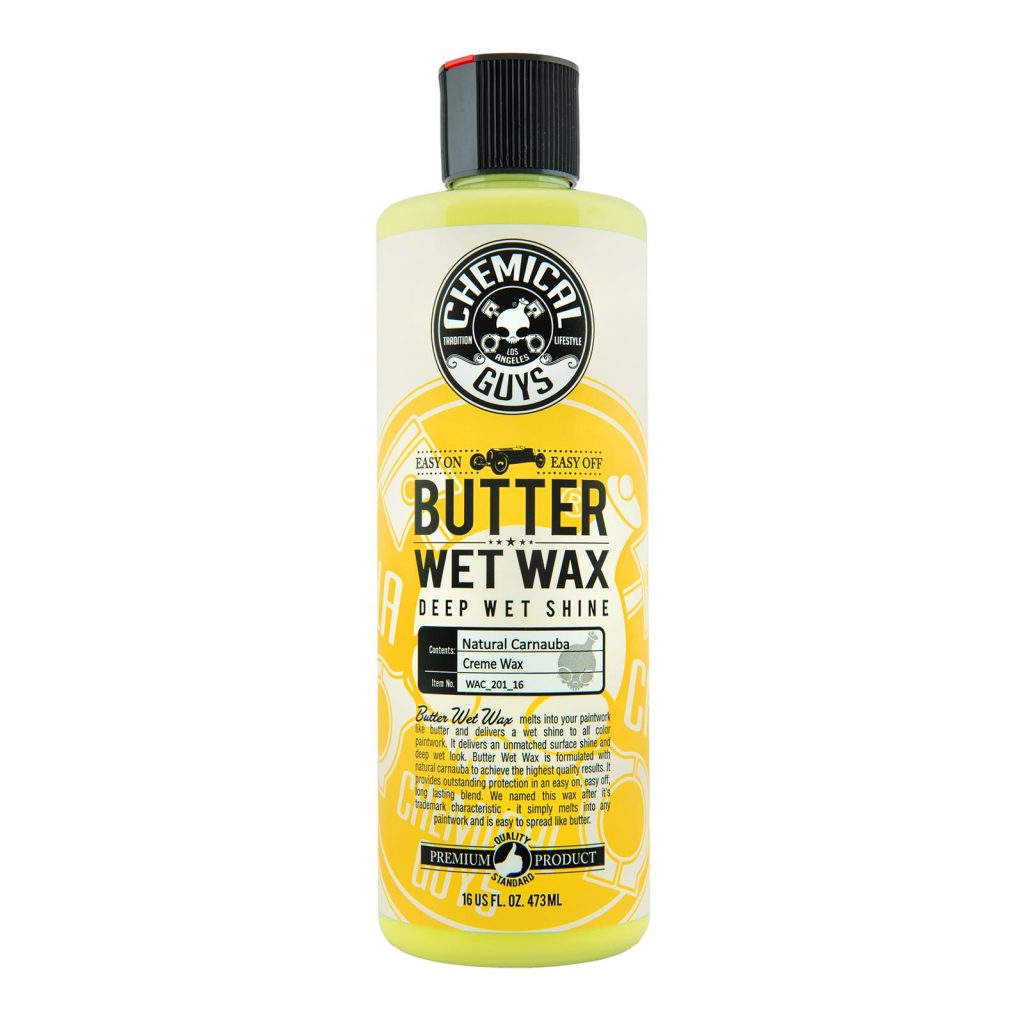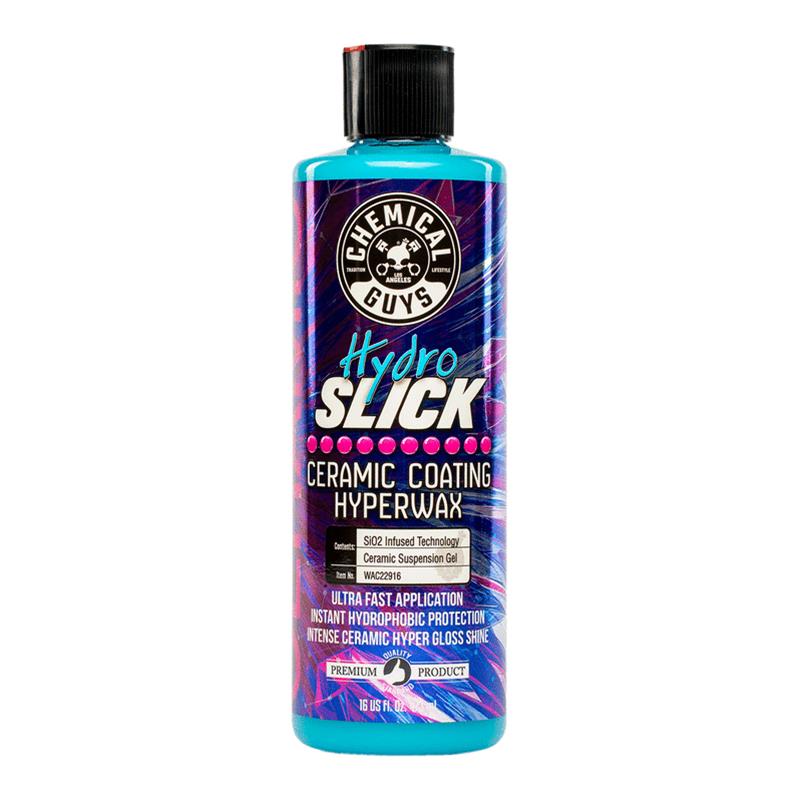Whether you’ve got a brand new car or truck for your daily commute, or a classic or custom vehicle that you’ve invested countless hours (and money) in building or restoring, you probably want to protect that investment.
Let’s be honest…you definitely want to protect that investment. And that includes keeping it looking good.
We’ve provided some insight here on how (and how not ) to wash and detail your vehicle.
Part of the equation includes the right combination of products — car wash soap, tire cleaner, glass cleaner, and other items. Among the most important ingredients: wax.
When most people think of car wax, they think of traditional, carnauba-style wax.
Lately, though, we’ve been getting questions about ceramic coating vs. traditional car wax. Below, we’ll cover the pros and cons of each.

Traditional Car Wax
The most common substance used for the protection of cars, trucks, and SUVs is referred to as carnauba wax. In its natural form, carnauba wax is secreted from palm tree leaves and creates a hard outer shell, which protects the leaves from harsh exposure to the sun.
Don’t be fooled, though.
Some wax brands market 100-percent carauaba wax, but this refers only to the wax ingredient itself. The final product also includes some combination of oil, solvents, colorants, and other ingredients that make product wax malleable. This type of wax is applied by rubbing it onto the vehicle’s exterior (usually in a circular pattern), letting it dry, then buffing out the residue until the finish is clean and shiny.
Car Wax: Advantages
- Environmental friendly since it’s a natural substance.
- Simple to use, although it can be time-consuming.
- Doesn’t require professional help, although advanced car wax application and polishing equipment does produce improved shine and protection.
- It’s heat resistant and will not wear thin simply due to excessive heat.
- Resists water very well.
Car Wax: Disadvantages
- Requires frequent reapplication: Some car waxes should be reapplied every four to six weeks for maximum benefit.
- Time-consuming and labor-intensive: You must wash the car first, completely dry it, prep it (sometimes by removing older wax build-up), applying, and then buffing.
- Can be confusing…not the process itself necessarily, but the purchasing process. There are some products that are marketed as car wax but really aren’t. A great example of this is the spray wax used at an automatic car wash, which is more of auto-body conditioner that washes off easily.

Ceramic Coatings
When we talk about ceramic coatings in this article, we’re actually referring to nano ceramic coatings. Whereas carnauba wax is natural, ceramic coatings are man made from a liquid-polymer that is derived from silica and is commonly used in the manufacturing of ceramic or glass products.
The word “Nano” refers to the size of the molecules or particles in the coating itself. These particles range from 80-100 Nano-meters. FYI – there are 25 million Nano-meters in an inch.
Ceramic coatings actually offer a curing property that chemically bonds to the surface or paint; traditional waxes simply sit on the surface and provide a barrier.
IMPORTANT NOTE: There is a difference between professionally applied ceramic coatings and DIY ceramic coatings, which are available at outlets like Summit Racing. Professional coatings take a tremendous amount of prep work, require the right environment and can cost hundreds of dollars…but can last several years. DIY ceramics are designed to offer some of the durability of the pro stuff, but reduce the prep time and cost.
Ceramic Coatings: Advantages
- Excellent UV protection, which protects the paint from oxidation, developing sun-damage.
- Longer lasting than car wax — depending on the product, nano-ceramic coatings can last several months and some professional ceramic coatings can last beyond a year or more!
- Resistant to contaminants like water, acid rain, bug splatters, and bird droppings.
- Great water resistance: Nano-ceramic coatings make washing and drying a car much quicker and they also resist water spots when drying naturally.
- Delivers an intense shine.
Ceramic Coatings: Disadvantages
- Typically more expensive than traditional, natural waxes, although DIY ceramics offer more affordability at the expense of durability.
- More detailed process that can require the help of professionally trained detailer or technician, depending on the product.
- Time-consuming: During the initial application, it’s recommended to keep the vehicle out of the elements for an extended period.
Which is Right for You?
Based on the pros and cons above, you can make a good guess based on your time, budget, and skill level. However, take the purpose of your vehicle into consideration.
If you’ve got a show car, you’ll love the brilliant shine of a ceramic coating, for sure. However, if you’re headed to a car show, a traditional wax will provide a nice glow and you can touch it up easily. A daily-driven car that spends a lot of time outside might benefit from a ceramic coating for superior protection and low maintenance. It depends on the harshness of the environment (UV rays, snow, pollution) in your area.
Those are a few of the considerations when choosing between car wax and ceramic coatings.
Happy detailing!

[…] Whether you’ve got a brand new car or truck for your daily commute, or a classic or custom vehicle that you’ve invested countless hours (and money) in building or restoring, […] Read full article at http://www.onallcylinders.com […]
Another thing to consider is shine and appearance. I have a 15 year old black car with lots of imperfections.
I tried the new ceramic spray coatings with disappointing results. The application and removal was not as easy as wax. It didn’t provide a deep shine and many imperfections were apparent. The paint water spotted after the first rain.
However, caranuba wax is much easier to apply and remove. The deep gloss it gives the old black paint is fantastic.
Maybe the ceramic spray coatings are best for new cars with fresh paint. But for older and darker paint I think wax is the way to go.
I like pickles.
Not that it matters in this case but there are 25 ‘billion’ nanometers in an inch. Sorry but I spent many years working with electrical engineers. Nitpicking must have rubbed off on me. 😉
After 50 years of owning cars I went ahead and purchased a professionally applied ceramic coating along with PPF with the intention, and belief of adding a high level of protection. What I discovered is that having used Carnauba until now, Carnauba protects better than ceramic however as the article states it must be reapplied several times per year. I recently was out of town and the car was rained on. The subsequent water spots cannot be removed without buffing and reapplying the ceramic coating for another $500. The installing dealer never gave me warranty information about the coating they applied and now refuse to acknowledge they did anything wrong. I have never had a issue with water spots lingering after a rain using carnauba. So for what it is worth I now believe ceramic coating to be a fraud and is only useful for display cars as an appearance product which ceramic does very well.